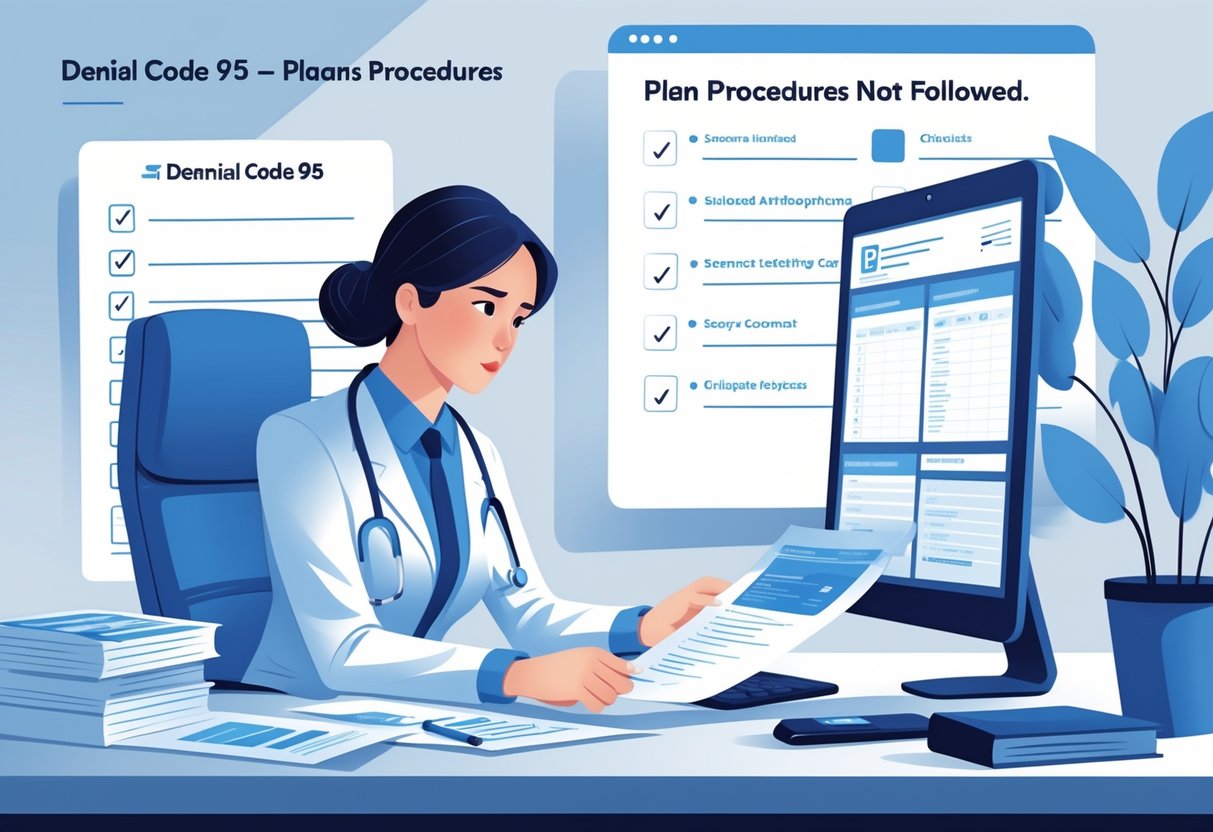Denial code 95 means that the plan’s rules or procedures were not followed when you submitted a claim. This denial happens because the insurance provider requires certain steps to be done, and if those aren’t met, they reject the claim. Understanding this code helps you avoid delays in payment or denied claims.
If you get this denial, it means you need to review the insurer’s guidelines carefully. It often involves missing forms, incorrect codes, or not following specific steps your insurance company demands. Knowing what went wrong is the first step to fixing it and getting your claim approved.
What Is Denial Code 95 – Plan Procedures Not Followed?

Denial Code 95 means a claim was rejected because the required steps set by a plan were not followed. This can happen during billing or approval processes and affects how payments are handled. You need to know what it means, how it applies in the industry, and who it impacts.
Definition and Explanation
Denial Code 95 indicates that a claim or request was denied because the rules or procedures established by an insurance plan were not followed correctly. This might include missing pre-authorizations, incorrect documentation, or filing outside of deadlines.
When you receive this denial, it means the carrier is saying you did not follow the specific plan rules. It is not about the medical service itself but about how you managed the administrative part.
This code helps insurers enforce their policies and avoid paying for claims that don’t meet their internal requirements.
Industry Context
In healthcare and insurance, Denial Code 95 is common during claims processing. Plans require certain steps to keep costs controlled and processes consistent. For example, a patient might need prior approval before a procedure, or a claim might need particular forms attached.
Failing to meet these requirements leads to a denial with Code 95, signaling you must correct the mistake. Providers, billing staff, and patients see these denials because they affect payment and care access.
Insurance companies use this denial as a tool to ensure you follow contractual rules and reduce improper payments.
Parties Impacted
Denial Code 95 affects multiple groups. Providers are often the first to see it because they submit claims. If their billing does not match plan rules, payment can be delayed or denied.
Patients also feel the impact since denied claims might mean they owe more out of pocket until the issue is resolved.
Insurance companies enforce the rules tied to this code to reduce fraud and errors. Billing specialists, office managers, and patients should understand how to prevent and fix these denials to avoid financial issues.
Common Causes of Denial Code 95

Denial code 95 happens when certain rules or steps required by the insurance plan are not followed. These errors usually come from missing approvals, wrong submission methods, or not sticking to the plan’s specific rules. Understanding these issues can help you avoid this denial.
Authorization Requirements Missed
You must get prior authorization before providing many services. If you do not get this approval, the claim denies with code 95. Insurance plans often require detailed information before giving permission.
Missing authorization can happen if you forget to check the patient’s plan details or submit the request late. Even if the service is covered, skipping this step causes denial. Always verify requirements and secure approvals to avoid this problem.
Incorrect Submission Processes
Claims must be sent with the correct forms and codes. Using wrong billing codes or submitting to the wrong place leads to denial code 95. Some insurers have strict rules about electronic vs. paper claims, and missing these rules causes issues.
You need to follow the exact steps your plan lists for claim submission. Double-check the submission format, claim details, and required attachments. Filing errors can cause delays or denials, so accuracy is key.
Failure to Adhere to Plan Guidelines
Each plan has unique rules about covered services, timing, and documentation. If you don’t follow these guidelines exactly, your claim can get denied with code 95.
For example, some plans require using specific providers or limits on service frequency. Missing these conditions triggers denial. Review and follow all plan instructions to make sure your claim is accepted.
How to Prevent Denial Code 95
To avoid Denial Code 95, you need to focus on detailed documentation, proper staff training, verifying authorizations ahead of time, and regularly checking your workflow. Each of these steps helps ensure you meet required procedures and reduce claim errors.
Accurate Documentation Practices
You must keep clear and complete records of every service, procedure, and communication. Use standardized forms and templates to make sure no critical details are missed. Double-check that all paperwork matches what was performed and billed.
Always include the plan’s specific requirements in your documentation. If tests or pre-approvals were needed, note them carefully. Accurate documentation helps show you followed proper procedures exactly as the plan requires.
Staff Training and Education
Your team needs up-to-date training on plan rules and how to document correctly. Hold regular sessions to review denial reasons like Code 95 and explain how to avoid them.
Teach your staff the importance of following each step in the plan’s procedure. Training improves accuracy and reduces mistakes that lead to denials. Make sure everyone understands the reasons behind these rules.
Utilizing Pre-Authorization Checks
Before claiming payment, verify if the service needs pre-authorization. Use electronic tools or contact the payer directly to confirm.
Set up alerts or checklists that help your team complete these checks every time. Pre-authorization errors are a common cause of Code 95 denials, so consistent checks are key to prevention.
Implementing Workflow Audits
Regularly review your clinical and billing processes. Use audits to find weak points where plan procedures might be missing or ignored.
Create a simple checklist for each step in your workflow. Track results to spot patterns and fix problems quickly. Audits keep your process aligned with payer rules and catch issues before claims are denied.
Steps to Resolve Denial Code 95
To fix Denial Code 95, you need to find where the mistake happened, correct any errors in your claim, and then talk clearly with the payer. Each step is important to get your claim approved and paid.
Identifying the Error Source
Start by reviewing your claim details carefully. Look for missing or incorrect information about the plan or procedures. Common errors include wrong procedure codes or missing prior authorizations.
Check if your provider followed the billing guidelines set by the payer. Sometimes, plans have specific rules that must be met before approval.
Use system reports or the denial reason given by the payer to pinpoint exactly what caused the denial. Getting the right source lets you avoid repeated mistakes.
Correcting Submission Mistakes
Once you know the issue, fix the claim data immediately. Update any incorrect codes or attach required documents like authorization forms.
Make sure all documentation matches the services delivered and the plan’s terms. Double-check plan requirements to avoid missing steps.
Resubmit your corrected claim through the proper channels. Use the payer’s preferred submission method to reduce delays.
Communicating With Payers
If you need clarification, contact the payer’s customer service directly. Be ready with claim numbers, patient details, and denial information.
Ask specific questions about the rules or documents they require. Keep a record of dates, names, and what was discussed.
Clear communication helps you understand exactly what the payer expects and how to fix issues quickly.
Implications for Healthcare Providers
You need to understand how denial code 95 affects your finances and patient care. Handling this denial properly requires attention to detail and efficient procedures to avoid repeated issues.
Financial Impact
Denial code 95 often leads to delayed or lost payments because the plan’s procedures were not followed. This means you might have to spend more time on re-submitting claims or appealing denials, which increases administrative costs.
You could see reduced cash flow if multiple claims are denied for this reason. If you don’t address the cause quickly, your practice might face larger revenue losses over time.
To reduce financial risk, you should review your billing processes thoroughly and train your staff to follow payer requirements exactly. Tracking denial patterns can help you spot weak points in your procedure.
Effects on Patient Care
When claims are denied under code 95, it often signals miscommunication or administrative errors. These can cause delays in treatment or confusion about coverage for your patients.
Patients might face unexpected bills if their insurance denies claims due to procedural errors. This can harm your relationship with them and increase patient dissatisfaction.
You must ensure that your staff checks insurance plans and authorizations before providing services. Clear communication and proper documentation support smoother claims and less patient disruption.
Frequently Asked Questions
You need to identify the exact plan procedures that were missed and review the claim details carefully. Correcting the claim often involves checking documentation and following the insurer’s specific rules.
What steps should be taken to correct a claim denied with denial code 95?
Start by reviewing the insurer’s plan procedures relevant to the claim. Then, gather any missing or incomplete documents. Resubmit the claim with all required information and proper codes.
Which specific plan procedures are typically referenced in a denial code 95 scenario?
Procedures often include prior authorization, eligibility verification, and adherence to coverage rules. Failure to follow any of these steps can trigger this denial.
Are there any common documentation issues that could lead to receiving denial code 95?
Yes, missing signatures, incomplete forms, or incorrect procedure codes are frequent problems. Inaccurate patient information can also cause the denial.
How can providers effectively prevent denials associated with code 95?
Check plan requirements before submitting claims. Use updated authorization and coverage information. Keep detailed, clear documentation to support every service.
What is the appeals process for a claim that receives a denial code 95?
You must submit a written appeal to the payer. Include evidence showing you followed plan procedures or why the denial was incorrect. Follow the payer’s deadlines carefully.
Can denial code 95 be anticipated based on certain plan types or coverage policies?
Yes, plans with strict prior authorization rules or detailed coverage policies often result in more code 95 denials. Knowing the plan’s requirements reduces your risk.








3 thoughts on “Denial Code 95 – Plan Procedures Not Followed Explained and Resolved Efficiently”